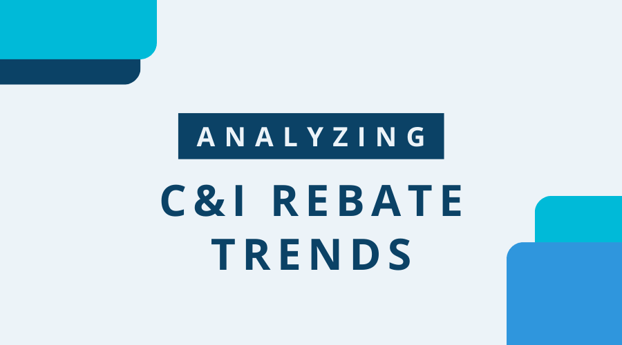
In March, Encentiv Energy hosted our annual Utility Rebates: What’s New in 2022 webinar where we reviewed information around 2022 utility rebate trends including LED rebate program changes by state, product category, and program for both downstream and midstream. View the webinar →
Various technologies were also included such as networked lighting controls, horticultural lighting, heating, ventilation, and air conditioning and variable frequency drives.
Gathering this information came through our Encentivizer tools which features our proprietary database which consists of thousands of utilities in the US and Canada that are analyzed and updated daily by our team of rebate experts, with tens of thousands of unique incentive calculations, as well as numerous details on hundreds of thousands of qualified products.
Interested in learning more about Encentivizer? We’d love to show you firsthand →
This information was gathered from mid-February 2021 to mid-February 2022 when most calendar year programs have completed their changes. Program changes were also filtered for changes in highest rebate value for each product category in each utility program over the mid-February 2021 to mid-February 2022 time period.
Looking for a specific technology?
LED | HVAC, VFD, & Advanced Rooftop Controls | NLCs & Horticultural Lighting
LED Rebates
LED Rebate Program Changes by State: Downstream
Just as in 2021, LED rebates for downstream programs overall remain flat. Lining up with COVID is not a coincidence as it has caused some uncertainty about where things are going, what's the access to commercial buildings and that leads to the flat trend and showing no change in utility programs on average.
However, a few utilities in some cases have increased their LED downstream rates by up to 33%, or down 13% on a state by state basis. Compared to 2021, those numbers were at 52% and down by about 28%.
From a technical perspective, what’s driving this lack of change are code advances in different areas, especially in California, the sunsetting of some programs, or a focus on the most highly efficient products in those categories in those states.
For where we're seeing higher rebates we can attribute this to programs having restarted their year as many programs run on two to three to five year cycles and this year the number of programs that restarted their cycle came out with larger rebates than they had at the end of the previous cycle. Additionally, Tennessee Valley Authority (TVA) is back with their lighting rebate program. They had ended it two or three years ago but have since resumed.
LED Rebate Program Changes by State: Midstream
Compared to downstream, there’s a little bit more increase with midstream. Connecticut and Pennsylvania are the high points with over 55% and 35%.
Both of these states have started their program terms over again. Pennsylvania is running on a new five year cycle that started up in June. In regards to a low point, Wyoming has a 20% decrease.
A trend is emerging where the midstream programs are really strong and over 50% of states are showing an increase and that's different compared to 2021 when stability was more the trend with midstream programs.
LED Rebate Changes by Program: Downstream
There are a number of programs that started or completely changed how they were organized.
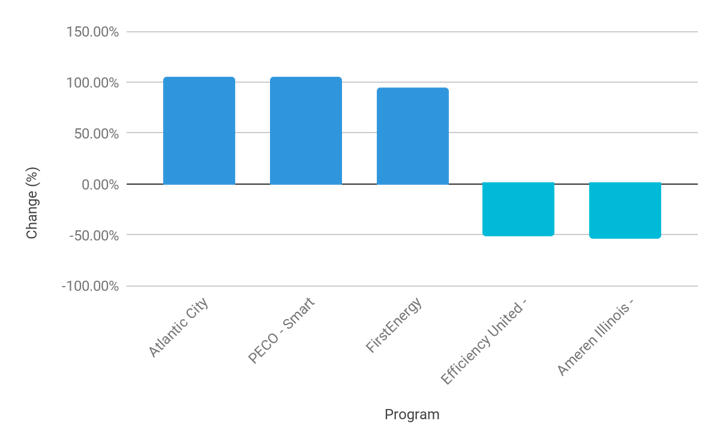
New Jersey had run a program centrally by a state level organization. Starting in mid-2021, they changed that structure such that individual utilities could be able to administer their own utility rebate programs. The state of Pennsylvania kicked off a new five-year program cycle in mid-2021 as well and with that, PECO and FirstEnergy made changes to their programs by increasing incentives.
Efficiency United in Michigan made some rate changes and Ameren Illinois vastly increased their rates during COVID and brought it back down to a more standard level following Encentiv Energy’s deadline of this information last year.
LED Rebate Changes by Program: Midstream
Compared to downstream, midstream programs shared some similarities. PECO overhauled their midstream program and improved their rates. In 2021, Efficiency Vermont was starting to trend downward but for 2022 they are trending upward as they relaunched a new program in the fall.
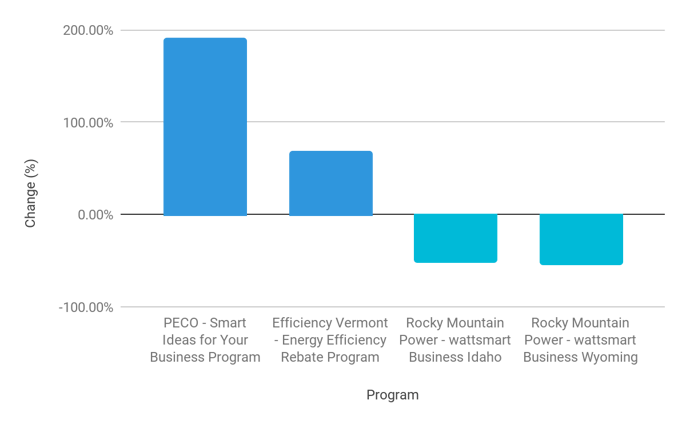
In regards to Rocky Mountain Power, they made some changes with HID replacement lamps, linear replacement lamps, and the 4-Pins that replace CFLs. Decreases in those categories contributed towards the negative trend and that can be from those categories being in their midstream programs for a while as utilities will scale back incentives for those as they bring in new product categories.
LED Rebate Program Changes by Product Category: Downstream
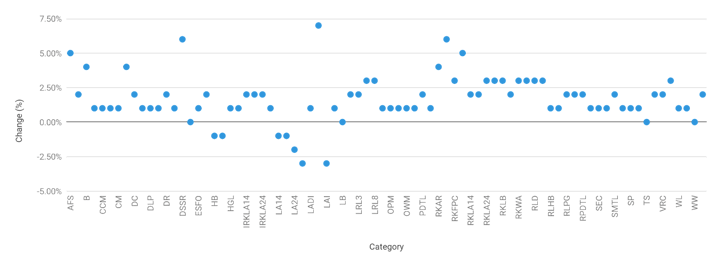
These product categories were sorted by codes that are based on the DesignLights Consortium® and Energy Star® categories. Aligning with what was shown on previous downstream data, stability is shown with the highest change of linear, ambient, and indirect of going up by 7%. The largest decrease occurred with troffers with a 3% decrease. In previous years, we saw as high as 20% with both increases and decreases but now it seems as if downstream incentives have stabilized.
LED Rebate Program Changes by Product Category: Midstream
In 2021 for midstream incentives, about 80% of product categories were within +10% or -10%. This year showed more of an upward trend. This reiterates the shift overall of LED towards midstream rebates.
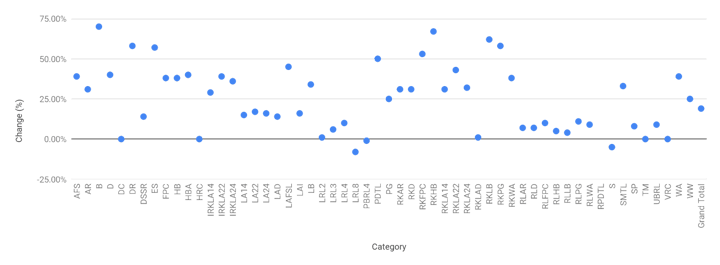
HVAC, VFD, and Advanced Rooftop Controls
HVAC
Given the growing focus on electrification and utility programs showcasing HVAC and expanding their offerings within this category, the addition of examining HVAC was a necessity. For this analysis, HVAC includes package rooftop units, split systems, variable refrigerant flow systems, mini splits, and packaged terminal units.
300+ programs, 830 utilities, 13m US business customers, 48 US states + DC, 9 CA provinces
Over 70% of downstream programs are stable with 20% increasing on average with some major increases in Mass Save and PECO which both have started new program cycles. These new program launches are giving these utilities the opportunity to raise incentive levels, similar to what was shown with lighting.
With midstream, existing programs are not showing changes but new programs are being introduced in 2022 and we expect that trend to continue.
As there continues to be more focus on electrification, programs and incentives will continue to grow and expand in this area with heat pumps getting more attention in addition to efficiency improvements across the board and the introduction of new technologies
Variable Frequency Drives
Variable Frequency Drives (VFD) are a computer or device that can be attached to a motor and help it be more efficient. It is widely rebated throughout the US and Canada.
230 programs, 587 utilities, 12m US business customers, 44 US states + DC, 8 CA provinces
From a rebate perspective, there were slight increases on average. While Rocky Mountain Power’s rebate incentive rates decreased, yet the VFD rebates were much higher. VFD’s only feature downstream rebates with applications focused in industrial, HVAC, agriculture, and recreation. Due to the reliable savings that VFD’s have been able to generate, grids are taking notice and IESO (Ontario) offers grid incentives.
Advanced Rooftop Controls
Advanced rooftop controls are becoming a fairly popular program within utilities. This technology combines a number of different technologies together into one larger incentive. To qualify for some advanced rooftop control incentive, you have to have a rooftop air conditioning unit with a working economizer to help with the controlling ventilation or use of outside air.
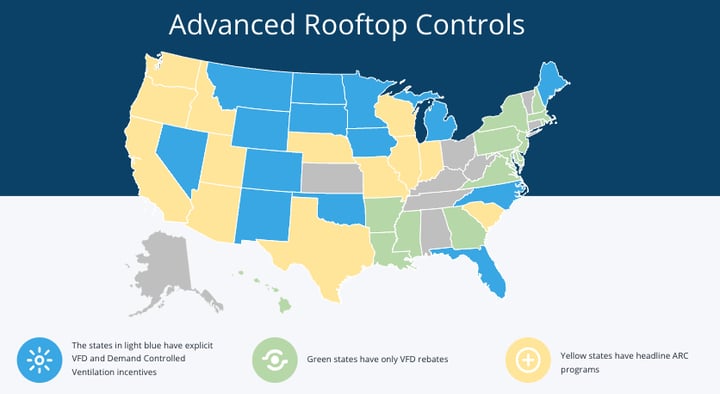
For a rooftop unit and economizer and then to add a VFD, there are very high incentives and very robust programs out there for this newer combination of technologies. For advanced rooftop controls (ARC), shown as the yellow states, these incentives can range up to $300 per ton controlled for installing these kinds of systems. The blue states showcase ones that have explicit VFD and Demand Controlled Ventilation incentives while green features states that only have VFD rebates.
Networked Lighting Controls and Horticultural Lighting
Networked Lighting Controls
LED adoption in the past few years has increased and that has been putting more pressure on utilities now to find other ways to generate energy savings. One of the main ways that programs are looking to generate those savings is related to networked lighting controls. Networked lighting controls allow for more dynamic control of lighting and thereby lead to more energy savings for rebate programs.
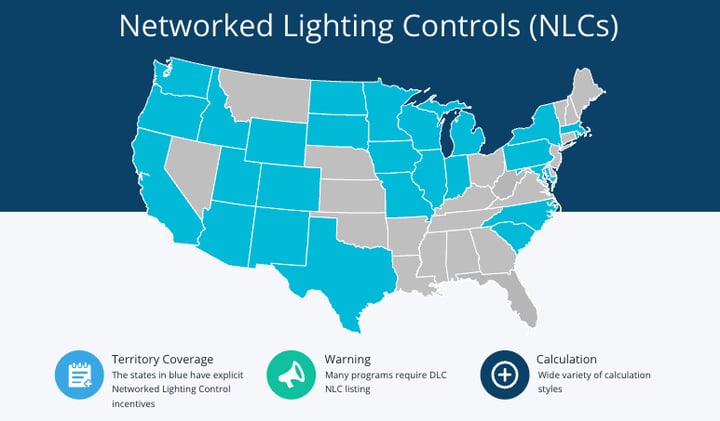
Compared to 2021, this is similar to what was shown related to coverage of where programs have explicit programs specifically for NLCs. However, it is still growing and incentives are increasing throughout the country. This map shows the territories where NLCs are specifically offered but for those not featured, it is available through custom programs.
Horticultural Lighting
For horticultural lighting, programs are starting to shift from custom calculations or calculated incentives to fixed prescriptive incentives which shows savings from this category are becoming more defined and thereby more accessible.
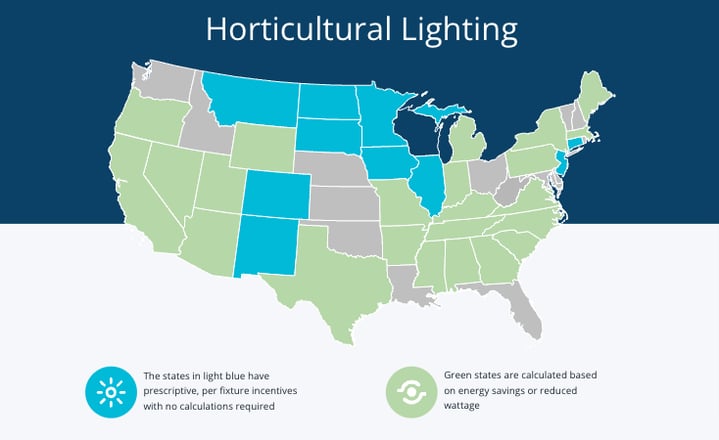
Shown in blue are states where there are prescriptive incentives offered for horticultural lighting. For those in green, these states are incentives offered on either per kWh basis or a kW reduced basis. For the next few years, prescriptive incentives should start to trend more compared to the kWh / kW option.
.png?width=500&name=2019%20e%20news%20spotlight%20logo%20(1).png)




